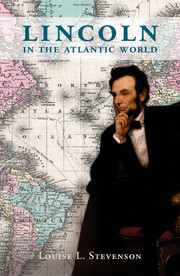Book contents
- Frontmatter
- Dedication
- Contents
- Acknowledgments
- Introduction: My Lincoln Lessons
- 1 The Second Shot Heard ’Round the World
- 2 African Lessons
- 3 European Lessons
- 4 German Lessons
- 5 English Lessons
- 6 Lessons from International Law
- 7 German Lessons for Reelection
- 8 The Last Lesson
- Notes
- Selected Bibliography
- Index
1 - The Second Shot Heard ’Round the World
Published online by Cambridge University Press: 05 November 2015
- Frontmatter
- Dedication
- Contents
- Acknowledgments
- Introduction: My Lincoln Lessons
- 1 The Second Shot Heard ’Round the World
- 2 African Lessons
- 3 European Lessons
- 4 German Lessons
- 5 English Lessons
- 6 Lessons from International Law
- 7 German Lessons for Reelection
- 8 The Last Lesson
- Notes
- Selected Bibliography
- Index
Summary
We will never know whether a British regular or a Massachusetts militiaman fired the first shot on the morning of April 19, 1775. It started a military skirmish that reverberated through lands on both sides of the Atlantic Ocean. The blast announced a new era in transatlantic world history that scholars now call the age of democratic revolutions. On July 4, 1776, representatives of the thirteen American colonies to the Second Continental Congress meeting in Philadelphia adopted the Declaration of Independence. Its words politically defined the new era with a bold statement of the bedrock beliefs of republicans around the world: all men are created equal, and governments depend on the consent of the governed.
The evening of April 14, 1865, five days short of four score and ten years after the confrontations at the village green in Lexington and the North Bridge in Concord, a single gunman fired another blast. Like the first shot, its report also resounded, first around the country and then around the world. Throughout the United States, people soon learned that John Wilkes Booth, the famous actor and sympathizer with the Confederate States of America, had pulled the trigger.
On the night of April 14, 1865, he purposefully had made his way from an alley behind Ford's Theatre in Washington, up to its Dress Circle, and into the presidential box, where Mary and Abraham Lincoln and their guests were enjoying the popular comedy. After drawing a derringer pistol from a concealed pocket stitched into the inside right leg of his tall leather boots, Booth waited for the hero of Laura Keene's Our American Cousin to draw guffaws from the audience with his line: “I guess I know enough to turn you inside out, old gal– you sockdologizing old man-trap.” As the presidential couple and members of the audience roared at the absurdity of these words, Booth squeezed the pistol's trigger and sent a lead ball into the skull of the President of the United States. Coming to rest just behind his right eye socket, the bullet ended his conscious life. (See Figure 1.1.)
Overcoming their shock and horror, doctors and soldiers carried the mortally wounded leader from the theater, across 10th Street, and to a second-floor bedroom in a three-story brick house.
- Type
- Chapter
- Information
- Lincoln in the Atlantic World , pp. 14 - 38Publisher: Cambridge University PressPrint publication year: 2015



